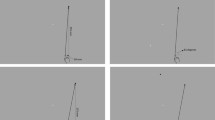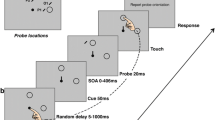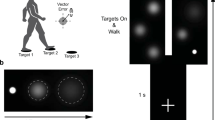Abstract
Locomoting-to-reach to a target is a common visuomotor approach behavior that consists of two nested component actions: locomotion and reaching. The information and control strategies that guide locomotion and reaching in isolation are well studied, but their interaction during locomoting-to-reach behavior has received little attention. We investigated the role of proportional rate control in unifying these components into one action. Individuals use this control strategy with hand-centric disparity-based τ information to guide seated reaching (Anderson and Bingham in Exp Brain Res 205:291–306. doi:10.1007/s00221-010-2361-9, 2010) and use it with sequential information to perform targeted locomotion to bring an outstretched arm and hand to a target; first with eye-centric τ information and then hand-centric τ information near the target (Anderson and Bingham in Exp Brain Res 214:631–644. doi:10.1007/s00221-011-2865-y, 2011). In the current study, participants performed two tasks: locomoting to bring a rigidly outstretched arm and hand to a target (handout), and locomoting to initiate and guide a reach to a target (locomoting-to-reach). Movement trajectories were analyzed. Results show that participants used proportional rate control throughout both tasks, in the sequential manner that was found by Anderson and Bingham (Exp Brain Res 214:631–644. doi:10.1007/s00221-011-2865-y, 2011). Individual differences were found in the moment at which this information switch occurred in the locomoting-to-reach task. Some participants appeared to switch to proportional rate control with hand-τ once the hand came into view and others switched once the reaching component was complete and the arm was fully outstretched. In the locomoting-to-reach task, participants consistently initiated reaches when eye-τ specified a time-to-contact of 1.0 s. Proportional rate control provides a solution to the degrees-of-freedom problem in the classic manner, by making multiple things one.


Similar content being viewed by others

References
Anderson J, Bingham GP (2010) A solution to the online guidance problem for targeted reaches: proportional rate control using relative disparity τ. Exp Brain Res 205:291–306. doi:10.1007/s00221-010-2361-9
Anderson J, Bingham GP (2011) Locomoting-to-reach: information variables and control strategies for nested actions. Exp Brain Res 214:631–644. doi:10.1007/s00221-011-2865-y
Bardy BG, Warren WH Jr (1997) Visual control of braking in goal-directed action and sport. J Sports Sci 15:607–620. doi:10.1080/026404197367047
Bootsma RJ, Craig CM (2003) Information used in detecting upcoming collision. Percept 32:525–544. doi:10.1068/p3433
Bootsma RJ, Oudejans RR (1993) Visual information about time-to-collision between two objects. J Exp Psychol Hum Percept Perform 19:1041–1052. doi:10.1037/0096-1523.19.5.1041
Bradshaw MF, Elliott KM (2003) The role of binocular information in the ‘on-line’ control of prehension. Spat Vis 16:295–309. doi:10.1163/156856803322467545
Coull JT, Vidal F, Goulon C, Nazarian B, Craig C (2008) Using time-to-contact information to assess potential collision modulates both visual and temporal prediction networks. Front Hum Neurosci 2:10. doi:10.3389/neuro.09.010.2008
Fath AJ, Fajen BR (2011) Static and dynamic visual information about the size and passability of an aperture. Percept 40:887–904
Fath A, Marks B, Bingham G (2013) Response to perturbation in constant tau-dot versus constant proportional rate models of visually guided braking. J Vis 13:747. doi: 10.1167/13.9.747
Higuchi T, Cinelli ME, Greig MA, Patla AE (2006) Locomotion through apertures when wider space for locomotion is necessary: adaptation to artificially altered bodily states. Exp Brain Res 175:50–59. doi:10.1007/s00221-006-0525-4
Hopkins B, Churchill A, Vogt S, Rönnqvist L (2004) Braking reaching movements: a test of the constant tau-dot strategy under different viewing conditions. J Mot Behav 36:3–12. doi:10.3200/JMBR.36.1.3-12
Kim N-G, Turvey MT, Carello C (1993) Optical information about the severity of upcoming contacts. J Exp Psychol Hum Percept Perform 19:179–193. doi:10.1037/0096-1523.19.1.179
Lee DN (1976) A theory of visual control of braking based on information about time-to-collision. Percept 5:437–459. doi:10.1068/p050437
Lee DN, Reddish PE, Rand DT (1991) Aerial docking by hummingbirds. Naturwissenschaften 78:526–527. doi:10.1007/BF01131406
Regan D (2002) Binocular information about time to collision and time to passage. Vis Res 42:2479–2484. doi:10.1016/S0042-6989(02)00086-X
Regan D, Hamstra SJ (1993) Dissociation of discrimination thresholds for time to contact and for rate of angular expansion. Vis Res 33:447–462. doi:10.1016/0042-6989(93)90252-R
Rock PB, Harris MG, Yates T (2006) A test of the tau-dot hypothesis of braking control in the real world. J Exp Psychol Hum Percept Perform 32:1479–1484. doi:10.1037/0096-1523.32.6.1479
Servos P, Goodale MA (1994) Binocular vision and the on-line control of human prehension. Exp Brain Res 98:119–127. doi:10.1007/BF00229116
Todd JT (1981) Visual information about moving objects. J Exp Psychol Hum Percept Perform 7:795–810. doi:10.1037/0096-1523.7.4.795
Wann JP, Edgar P, Blair D (1993) Time-to-contact judgment in the locomotion of adults and preschool children. J Exp Psychol Hum Percept Perform 19:1053–1065. doi:10.1037/0096-1523.19.5.1053
Warren WH Jr, Whang S (1987) Visual guidance of walking through apertures: body-scaled information for affordances. J Exp Psychol Hum Percept Perform 13:371–383. doi:10.1037/0096-1523.13.3.371
Yilmaz EH, Warren WH Jr (1995) Visual control of braking: a test of the τ hypothesis. J Exp Psychol Hum Percept Perform 21:996–1014. doi:10.1037/0096-1523.21.5.996
Zaal FTJM, Bootsma RJ (1995) The topology of limb deceleration in prehension tasks. J Mot Behav 27:193–207. doi:10.1080/00222895.1995.9941710
Conflict of interest
The authors declare that they have no conflict of interest.
Author information
Authors and Affiliations
Corresponding author
Rights and permissions
About this article
Cite this article
Fath, A.J., Marks, B.S., Snapp-Childs, W. et al. Information and control strategy to solve the degrees-of-freedom problem for nested locomotion-to-reach. Exp Brain Res 232, 3821–3831 (2014). https://doi.org/10.1007/s00221-014-4072-0
Received:
Accepted:
Published:
Issue Date:
DOI: https://doi.org/10.1007/s00221-014-4072-0



